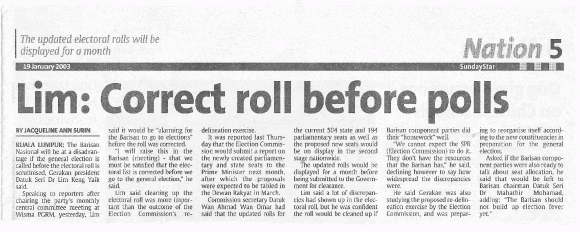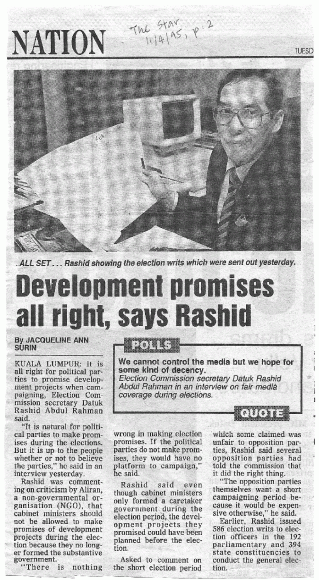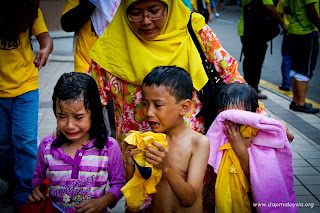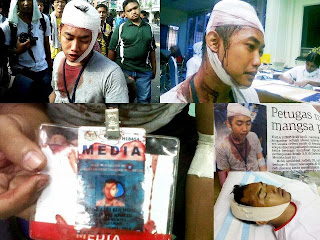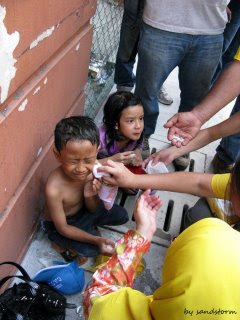
2012年7月13日 星期五
2012年6月29日 星期五
2012年5月14日 星期一
Who says the EC is independent?
FRANKLY, I wasn’t surprised at all when it was reported in late April that both the Election Commission (EC) chairperson and deputy chairperson were Umno members. Even without evidence of party membership and despite the EC deputy chairperson’s subsequent U-turn and denial, it would not be a stretch to imagine both the chairperson and his deputy are Umno members.
I don’t doubt PKR’s announcement about the top EC leaders’ purported political membership was strategically timed to be released a day before the 28 April 2012 Bersih 3.0 protest. Clever strategy aside, Umno membership alone isn’t the only evidence of the EC’s lack of independence. The evidence has been mounting over the years.

Wan Ahmad Wan Omar
What other proof do we have? And how can we be oh-so-certain that the EC is not independent even if it’s eventually demonstrated that neither Tan Sri Abdul Aziz Mohd Yusof nor Datuk Wira Wan Ahmad Wan Omar are members of any political party?
A subservient commission
Firstly, every single member of the EC, including the chairperson and deputy chairperson, is a former civil servant. The most recent appointment, Datuk Christopher Wan Soo Kee, was formerly the former Kuala Lumpur Special Branch chief. This composition in itself sets the EC up for bias since civil servants’ professional training is to carry out the wishes of the government of the day.

Abdul Aziz Mohd Yusof
This point was made by Bersih 2.0 in its recommendations to the Parliamentary Select Committee (PSC) on Electoral Reform in November 2011. It argued that in a country where only one coalition has formed the federal government since 1955, “inevitably, senior civil servants slowly stop making the distinction between the government and the political party”. That includes the Royal Malaysian Police Force as well, which has often demonstrated that BN events can proceed without a hitch while Pakatan Rakyat functions are often prevented from going ahead.
Bersih 2.0’s claim is supported by the testimony of EC officials themselves. In an interview by a team of researchers with the top three EC officials in the 2000s, the then chairperson, deputy chairperson and secretary said it was “normal for them to see the prime minister even before constituency reviews were begun”. The chairperson added that “as a practical matter, requests for meetings by ‘number one and number two’ could not be refused, unlike similar requests from lesser political leaders”. [1]
It is not only academics who have reported on the subservient relationship between the EC and the government of the day. In the course of researching for this column, I found an old news report I wrote in The Star on 19 Jan 2003. The article quotes the then EC secretary as saying that the commission would submit the updated electoral roll to the government for clearance after it had been displayed.
Many citizens have also witnessed first-hand the EC’s subservience to the BN. At a Bersih 2.0 public forum on 21 Feb 2011 in Petaling Jaya, for example, Wan Ahmad’s constant refrain was: “We can propose [reforms] but ultimately, the government decides.”
Competency or complicity?
Then there is the long-standing issue of gerrymandering and unconstitutional malapportionment. Through the years, the EC has redrawn the boundaries of constituencies in ways that have benefited the BN. Is that the mark of an independent commission ensuring free and fair elections?
And there’s been the refusal by the EC to take the BN to task for vote buying through the use of taxpayer’s monies to offer development projects just before the polls. This was most recently notable during the 2011 Sarawak state election. Indeed, it was the EC’s stubborn refusal to even speak up against or investigate the potential violations under the Elections Offences Act in Sarawak that compelled Bersih 2.0 to organise its mammoth rally on 9 July last year.
To be fair to the current EC leadership, chairperson Abdul Aziz is only following in the previous EC leadership’s footsteps. In 1995, then EC secretary Datuk Rashid Abdul Rahman declared there was “nothing wrong in making election promises” during an election campaign:
What does the EC’s apparent ignorance of these election breaches tell us? It tells us that even if the EC leadership are not Umno members, they are either incompetent or complicit with the BN. And it would seem that they have been for at least the past 17 years.
Rescuing the EC
Many academics have, for the past 15 years or more, noted how unfair and problematic our electoral system is. In 1996, notable Australian academic Harold Crouch wrote: “The Malaysian electoral system … [has been] so heavily loaded in favour of the government that it is hard to imagine that [it] … could be defeated in an election.” Ten years later, another academic, J Funston, echoed the same sentiment because nothing had changed. Funston wrote that “EC activities frequently provided direct benefits to the BN”.
How can the EC be rescued? The EC may think that merely choosing a “non-aligned colour” instead of yellow in its logo will do the trick. However, the mountain of evidence that the EC is either incompetent at its best, or not independent at its worst, means much more needs to be done.
In its recommendations to the PSC on Electoral Reform, Bersih 2.0 proposed several measures that would ensure Malaysians had an EC they could have confidence in. One, why can’t we have an EC that comprises more than just retired civil servants? If necessary, the number of commissioners can be increased to ensure wider representation and expertise.
Two, some of the issues we face can actually be addressed by establishing a Code of Conduct, as practised in India, which spells out best practices for all parties and candidates during an election. This code of conduct could also be applied to the media so that newsrooms can be pressured to ensure fair coverage of all candidates and parties no matter their political affiliations.
And three, if the EC is to regain some semblance of credibility, it needs to reclaim its power to make rules under Article 113(5) of the Federal Constitution. These rules can be used to prohibit the use of public institutions or government machinery in election campaigns.
The question, of course, is whether the EC wants to be rescued. If the growing evidence of more than a decade is anything to go by, I doubt it. And if the EC won’t reform itself of its own volition, what else are citizens left to do? ![]()
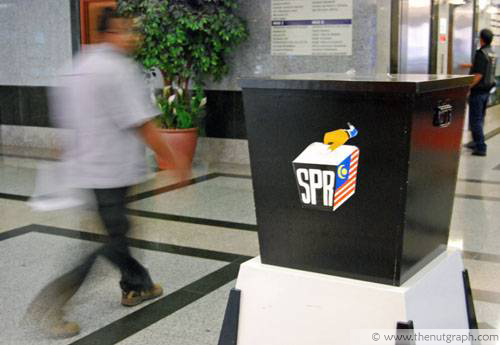
[1]
Lim, HH (2005) “Making the system work: the Election Commission”, in Putucheary, M and Othman, N. (ed.), Elections and Democracy in Malaysia, Universiti Kebangsaan Malaysia, Bangi, p.263.
http://www.thenutgraph.com/
THE SIGNIFICANCE OF BERSIH
Poem written by Allan Goh, Malaysian citizen.
Bersih is the people’s movement:
There is no subscribed membership,
Nor a registered society.
It is a spontaneous grouping
Of free, like-minded citizens,
Who believe in democracy,
Transparent and impeccable.
Bersih does not ask for the sky;
It only wants clean elections.
It is helmed by a committee
Of people with integrity,
Deeply concerned with the faulty,
Fraudulent electoral roll.
These brave civic individuals,
Voluntarily give their time,
Resource, effort and energy.
Bersih does not ask for the sun;
It only want fair elections.
Voting in a democracy
Is the most basic human right.
It is an open avenue
For the expression of free will,
For the choice of good governance.
This means the careful selection
Of moral principled people.
Bersih does not ask for the moon;
It wants only just elections.
Only a clean, fair election
Can ensure the installation
Of a responsible government,
Of, by and for all the people,
Based on the best human values,
For a true, progressive nation,
Steeped in democratic values.
Bersih does not ask for the earth;
It wants only free elections.
If Bersih deserves the label
Of anti- anything at all,
It is anti-lies and scandals,
Anti-vile manipulations,
Duplicities and corruptions,
And obstacles against justice.
Fair minded people will align
Themselves with justice and fairness.
Bersih does not ask for the world;
It wants only true elections.
Bersih does not coerce nor threaten.
Its principle is non-violence,
To convey its message to all.
When its clarion call to action
Of peaceful protest comes around,
Citizens response with true grit.
It finds a resonance with folks.
Bersih does not ask for the gold;
It wants only real elections.
The ray of hope for real freedom,
Lives on in people’s mind and soul,
That empowers them as Malaysians
To seek a better tomorrow.
The vast silent majority
Will not be silenced any more,
Making them scorn the gun barrels.
Bersih does not ask for fame;
It wants only right elections.
Solutions and resolutions
Are the aims of Bersih rally:
Not confrontations, not rabble
Rousing, not any form of violence.
Demonstrations are just folks’ tools
To focus on the glaring wrongs
(So blind to the authorities).
Bersih does not ask for blames;
It does not want vile elections.
Bersih is an idealism,
That draws the voluntary mass,
For the struggle of human rights,
Through a clean electoral college.
Bersih started as a groundswell,
That sweeps across the whole nation,
Building up into a tsunami.
Bersih does not ask for troubles;
It does not want dirty elections.
The Bersih tide will get bigger,
Suffused with real democracy.
It’s the life blood of true freedom.
Bersih embraces all races,
All religious groups, both genders,
All age groups, and all professions.
Righteousness is the common glue.
Bersih does not want any strife;
It wants a clean, fair election!

2012年5月13日 星期日
428, The Malaysian Bar Resolution states:
(1) The Malaysian Bar views with grave concern, and condemns:
(a) the excessive, indiscriminate and wrongful use of water cannons and tear gas by the police on participants of the assembly;
(b) the action of the police in not allowing the crowd sufficient time to disperse in an orderly and safe manner, and instead chasing the participants and attacking them by persistently shooting water cannon and tear gas on them;
(c) the tactics of the police in trapping and attacking the participants with water cannon and tear gas instead of permitting them to disperse;
(d) the random, widespread and wanton physical assault and brutality by the police on members of the public and media professionals;
(e) the unwarranted arrests of members of the public, media professionals and Members of the Bar, and the physical assault and beating of at least three arrested Members;
(f) the unjustifiable and unlawful confiscation and/or destruction of photographs and video recordings made by members of the public and media professionals, and damage caused to their recording equipment; and
(g) the lack of discipline and professionalism of the police; (...)
Read the full rsolution at:
www.malaysianbar.org.my/malaysian_bar_s_resolutions/resolution_adopted_at_the_extraordinary_general_meeting_of_the_malaysian_bar_held_at_sunway_putra_hotel_kuala_lumpur_friday_11_may_2012_.html
2012年5月9日 星期三
2012年5月7日 星期一
馬政府四大錯誤
政治学家碧莉洁威尔斯(Bridget Welsh)认为,国阵政府内部的强硬分子已经错误判断净选盟大
碧莉洁目前是在新加坡管理大学任职。她认为,在这次净选盟集会当
她形容,前者是“民主国族主义者”(democratic nationalists),而后者是“反动国族主义者”(re
她表示,对民主国族主义者而言,净选盟3.0集会是群众起义。它
超越个别领袖代表广泛民众
碧莉洁(左图)表示,反动国族主义者并没有意识到他们的抹黑,其
第一个错误就是将净选盟集会等同是在野党。
她表示,尽管民联和公民社会领导的净选盟在改革问题上拥有共同的
“这是关于制度改革和更好的代表权,包括在在野党的部分....
多年分歧在一个下午被打破
她说,反动国族主义者第二个错误就是把净选盟视为是一个种族分裂
她指出,尽管种族身份对大马政治还很重要,但是对集会者而言,这
“马来人、华人、印度人、卡达山人、伊班人和更多种族彼此相遇、
她表示,这场集会的效应就是协助建立了在野党支持者之间的信任,
今年集会人数比去年多一倍
讽刺的是,反动国族主义者却低估了这次集会抵消大马政治恐惧的效
碧莉洁表示,大马人的勇气正在增长当中,保守估计,今年净选盟3
“如果有关当局认为人民不会再度站起来,那只是在愚弄自己。”
“净选盟保守而言直接影响逾20%选民,间接影响则更多。大量年
漠视多数人民认同选举改革
她说,反动国族主义者最后一个错误就是继续漠视这次集会的主要诉
“不管人民对净选盟的伎俩和个人有什么看法,大多数大马人都认为
纳吉采强硬立场稳固基本盘
碧莉洁表示,现在看来我国越来越有可能最早下个月就举行大选,而
“媒体大肆报道翻车事件,和它所导致的暴力事件,是旨在把乡区地
“这些伎俩再加上(国阵在)选举制度先天的优势,以及东马的支持
不过,碧莉洁警告说,纳吉采取对抗而不是妥协方式是非常危险的。
“政府至今都没有接触净选盟,同时也没有真诚改革选举的管道。尽
强硬镇压只会引起更大反弹
第二则是因为它假设纳吉可以控制那些采取强硬立场的人士。不过,
“在这场权斗之中,到底还会有多少个机关会受到妥协,以采取更独
她表示,更令问题变得复杂的是,许多国阵人物已经越来越变得“非
“后1999年烈火莫熄家庭成员两极化的日子将再度来临,但这次
更难推行经济改革破除贪污
碧莉洁进一步表示,纳吉奉行强硬政治方式只会让他更难在现实中推
“屈服于强硬的政治立场只会打击经济改革,并且鼓励滥用资源来赢
“事实上,反动国族主义者错误估计社会运动的崛起,将让纳吉的领
政治学家碧莉洁威尔斯(Bridget Welsh)认为,国阵政府内部的强硬分子已经错误判断净选盟大
碧莉洁目前是在新加坡管理大学任职。她认为,在这次净选盟集会当
她形容,前者是“民主国族主义者”(democratic nationalists),而后者是“反动国族主义者”(re
她表示,对民主国族主义者而言,净选盟3.0集会是群众起义。它
超越个别领袖代表广泛民众
碧莉洁(左图)表示,反动国族主义者并没有意识到他们的抹黑,其
第一个错误就是将净选盟集会等同是在野党。
她表示,尽管民联和公民社会领导的净选盟在改革问题上拥有共同的
“这是关于制度改革和更好的代表权,包括在在野党的部分....
多年分歧在一个下午被打破
她说,反动国族主义者第二个错误就是把净选盟视为是一个种族分裂
她指出,尽管种族身份对大马政治还很重要,但是对集会者而言,这
“马来人、华人、印度人、卡达山人、伊班人和更多种族彼此相遇、
她表示,这场集会的效应就是协助建立了在野党支持者之间的信任,
今年集会人数比去年多一倍
讽刺的是,反动国族主义者却低估了这次集会抵消大马政治恐惧的效
碧莉洁表示,大马人的勇气正在增长当中,保守估计,今年净选盟3
“如果有关当局认为人民不会再度站起来,那只是在愚弄自己。”
“净选盟保守而言直接影响逾20%选民,间接影响则更多。大量年
漠视多数人民认同选举改革
她说,反动国族主义者最后一个错误就是继续漠视这次集会的主要诉
“不管人民对净选盟的伎俩和个人有什么看法,大多数大马人都认为
纳吉采强硬立场稳固基本盘
碧莉洁表示,现在看来我国越来越有可能最早下个月就举行大选,而
“媒体大肆报道翻车事件,和它所导致的暴力事件,是旨在把乡区地
“这些伎俩再加上(国阵在)选举制度先天的优势,以及东马的支持
不过,碧莉洁警告说,纳吉采取对抗而不是妥协方式是非常危险的。
“政府至今都没有接触净选盟,同时也没有真诚改革选举的管道。尽
强硬镇压只会引起更大反弹
第二则是因为它假设纳吉可以控制那些采取强硬立场的人士。不过,
“在这场权斗之中,到底还会有多少个机关会受到妥协,以采取更独
她表示,更令问题变得复杂的是,许多国阵人物已经越来越变得“非
“后1999年烈火莫熄家庭成员两极化的日子将再度来临,但这次
更难推行经济改革破除贪污
碧莉洁进一步表示,纳吉奉行强硬政治方式只会让他更难在现实中推
“屈服于强硬的政治立场只会打击经济改革,并且鼓励滥用资源来赢
“事实上,反动国族主义者错误估计社会运动的崛起,将让纳吉的领
By: We want to change
428 testimony of police brutality
Kumar was kicked by more than 20 policemen, they only stopped untill a police officer said: " Dia dah hampir mati, biar dia." He sad : " At this particular moment, laws didnt exist."
2012年5月4日 星期五
傳載

人在现场
这是个风和日丽的早上。不,应该说是烈日高挂的早上。
我和Bii出门载了Aaron和Worm,就前往Tam
...
吃完早餐,我们就出发前往市中心。不知怎么,白蒲大道给
一路上有说有笑,也有了些小插曲,因为有些路段被警察封
结果,幸运的,我们可以驱车直捣吉隆坡,把车停在陈氏书
我只看见马来西亚人
说真的,天气很热!
还没走进茨厂街,远远就可以听到口号声“BERSIH BERSIH,HIDUP BERSIH!”内心,开始澎湃,去年709的画面历历
时间过得好快,九个月就这样飞逝。可悲的是,政府并没有
于是,BERSIH3.0引爆!
茨厂街好热闹,人山人海,都为了同一个目标而来。这是个
去年我说过,我看不见华人,看不见马来人,也看不见印度
跟许多朋友学弟重逢
陆陆续续,人潮越来越多,天气也越来越热。还没开始游行
这一次,有别于709,多了好多好多好兄弟们,让我不再
时间踏正午时12点。在古时候,午时是把犯人送上断头台
全部人开始动起来了。四面八方不断涌入人群,以华人居多
除壮观别无其他形容
大家缓缓在苏丹街移动,走走停停,一下子喊口号,一下子
这,才叫做马来西亚。
游行队伍走过苏丹街,穿过了大街,一路上看见了站岗的警
来到了Jalan Masjid,我被当下的那一幕震撼住了。一眼望去,无
我拉着Bii的手,怕他在人群中走丢了,也因为人潮汹涌
在这里,很幸运的让我遇到偶像,八打灵再也北区国会议员
人群中,又让我遇见了一群歌手艺人朋友,如Steven
我和Bii继续往目的地:独立广场挺进。
上半场圆满和平举行
我对天发誓,肉眼望到的,都是人潮,少说也有十万人,穿
我们没有政治背景,更不是马华公会的人所说的甚么政治化
我们丢下工作,上街捱热游行,只为了为自己与下一代争取
这,有过分吗?
人潮几乎包围着独立广场,口号声此起彼落,各方人马不停
可是,不果。
无论如何,上半场的集会总算圆满举行,没有骚乱,没有暴
马来人开车门收容Bii
忽然间,现场气氛急转直下。
只看见远处靠近吉隆坡高庭那里开始冒烟,是催泪弹!!
一大群警察往后撤退,前线的民众涌进了独立广场。水炮车
混乱,正式开始!
我拉着Bii,在惊慌的人群中逃跑。看着人们四处逃跑,
因为,最危险的地方也是最安全的。
催泪弹不断往人群逃跑的方向射过去,我们则往前走了过去
突然有位好心人过来接应,把Bii带到了广场对面一个废
有个友族同胞打开车子让Bii进去车里避难,我则因为车
大马皇家流氓的服务
这时候,我马上就见证了大马皇家流氓的服务!
两个警察向我走了过来,大声呼吼我离开。我就走过去告诉
突然间,第三个警察从我身后把我架了起来,说“kamu
带走我的,就是后来出现在新闻片段上架着我的那一个。
一从停车场走了出来,迎面走来一个很魁梧的警察,一巴掌
我根本不想反抗,也无力反抗,一直说“I did nothing,why you hit on me?”没有人愿意回答,只是不断有人说,“You nak jadi samseng,nak jadi hero ke!?”
负责押送我的那个警察也不管我跌倒在地,就一直扯着我的
任伤者在烈日下暴晒
一直被带到广场旁的一个空地,一堆民众早已经被捉了安顿
这时候,经过的警察有事没事都往我们身上揍,往身上踢。
我们被警告不可使用手机,不可与外界接洽。
我很担心,因为Bii还在马来人的车上。而她的所有东西
我脑海开始组织很多很多的可能性,不断告诉自己要冷静。
由于被禁止使用手机,我不能打任何的电话。我唯有偷偷在
只是,到处都还烽火连连,朋友们能做的依然非常有限。
没有人能够做些甚么,当中有些受伤比较严重的人,并没有
律师一到马上变友善
较后,来了一位穿大衣的律师,警察马上变得友善起来,真
我询问律师,“Do we have right to use our mobile phone?”
律师说,“why not?”
我又说,“But they don't allow us to use.”
律师说,“if they ask u to stand on your head, will you do it?”
我心里在想,这群王八蛋无法无天,完全不跟警察执法守则
因为,我们是无法跟他们沟通的,更别想跟他们理论!
幸好,Bii得到一些公众的协助,成功搭的士回家,报了
这明明就是安排的局
一个又一个民众被押了过来,人数达到将近一百人,小者年
我们全部人被取走身分证后,留在现场曝晒大概两个小时,
大约等了三个小时,我们被送往警察训练中心。一车又一车
因为,现场早就准备好要迎接我们。棚子搭好了,食物饮料
后来者伤势越加严重
现场人数越来越多,伤势也一个比一个严重。有些骨折,有
但是,有更多是完全的路人甲乙丙丁,平白无故遭受痛打而
由此可见,大马皇家警察已经完全符合流氓的称号。从原本
只是,大马国阵政府多年来的纵容,已经把他们养成合法流
幸好,我临出门前带了ipad,让我可以在手机完全没电
当报导出现后,我被捕的画面疯传全世界,有个在Doha
我们全部人在里面被陆续登记后,都被一个个拍了照。感觉
干!我真是有为青年啊!
凌晨两点多才被释放
由于人数大约有四百人,登记的工作花了好长好长的时间。
幸好在里面认识了一群难兄难弟,大家不约而同的谴责警方
我通过面子书,得知有好多的媒体,政治人物以及律师公会
警方开始分批释放我们,一个一个名字被叫了,每个人都希
很感谢在里面认识的其中一个斗士,MICHAEL BEE,自己被释放后还留在外面等我出去,更安排了交通
“下一次可能就是你”
回到家,凌晨将近四点钟。
身心疲累,却倍感窝心。
一大堆的留言要回,一大堆的关心要还。
总结这一次的事件,让我更加确定一件事,再让国阵执政,
你可以选择不相信我,但就我昨晚经历过的事情,足以告诉
这一次我幸运,可以走着进去,走着出来。下一次,你确定
要改变这个国家,唯有从自己做起,更要不断影响身边的人
大马主流媒体,报章都已经成为国阵政府粉刷太平,制造不
有参与这次BERSIH3.0静坐集会并享用过纳吉为我
我再次呼吁,所有人杯葛本地报章,包括星州日报,中国报
钟糛颉
2012年5月2日 星期三
BBC News on Bersih 3.0 - What the government doesn't want you to know
On the left, BBC's original broadcast of the 10PM (Malaysian time) news on the 28th of april 2012. On the right it's what astro was broadcasting. There was about 5 minutes delay on the malaysian version, so they had time to censored it.
As some people misunderstood what I did here, there was no freeze frame and censored word on the astro broadcast, that was added by me to show you what part were censored from astro broadcast and keep the two videos in sync.
All content material are the property of the BBC.
马来西亚律师公会「428黄绿大集会」的初步监督报告
律师公会主席林志伟指出,根据律师公会监督小组的监督结果,428大集会截至下午3时都显得非常和平,直至警方发射水炮及催泪弹,才导致整个集会陷入一片混乱。
他说,警方在部分示威者闯入禁区后,並未通过口头劝说的方式来驱散人群,反而向人群发射催泪弹及水炮,违反马来西亚人权委员会针对2006年5月28日吉隆坡双塔楼和平示威向警方所提出的建议。
根据人权委员会的报告,委员会建议警方及联邦后备队在使用武力时,必须將国际规格列入警方的標准守则里,这包括按照「口头劝说、徒手制止、使用非致命武器制止、使用衝击武器制止以及使用致命武器制止」这5项步骤来驱散人群。「若民眾违反庭令而闯入禁区,警方应该做的是逮捕这些破坏和平者,而不是向所有正在和平请愿的人群发射催泪弹和水炮。」
林志伟今日公佈律师公会监督小组的初步报告时指出,人权委员会当时所举出的各项建议符合多个国家的警方行动守则,例如美国纽约警察、澳洲维多利亚警察甚至是埃及警方。
警察必须落实转型
他举例,喀什米尔、埃及及菲律宾警方行动守则都阐明,禁止警方將催泪弹及水炮直接射向人群中,而是旨在驱散人群。
他也说,与709净选盟2.0大集会相比,警方这次拒绝让律师公会成为大集会的官方监督单位,导致律师公会在监督整个大集会时面临更大的阻扰。
他重申,大马皇家警察必须落实转型,这包括成立独立警察投诉与行为不检委员会。
此外,他强调,警方在当天逮捕了多达471名民眾后,律师公会的紧急逮捕法律援助小组在第一时间抵达警察训练中心以提供协助时,却被警方拒於门外。
他说,这已违反联邦宪法第5(3)条文,即任何遭逮捕者都必须告知被捕原因,同时应获得及时的法律辩护和援助。
律师公会宪法委员会主任沙里占指出,他当时与数名律师公会成员抵达现场后,发现许多被逮捕者的家属也遭到警方的漠视。「除了不被允许接触被逮捕者,一些民眾只不过是前来確认他们的家属是否遭到逮捕,也遭到警方的无视。」
他举例,数名家长因接获未成年孩子被逮捕的消息而前往確认却不得要领,「直至隔天的凌晨4时,最后一名未成年的被逮捕者才获得释放。」
无论如何,律师公会副主席梁肇富指出,吉隆坡刑事调查主任拿督邱震华高级助理总监遵守承诺,陆续释放所有被扣者。
当时人在现场的他认为,警方在衡量国家安全及人权方面显然失败,「若人群突破警方的防线,最糟糕的情况会是什么?那也是不过是约10万人和平静坐在草地上两个小时。」
收集资料及证据带上法庭
大马律师公会主席林志伟说,不排除將向遭到警方暴力对待的集会者收集资料及证据,以將警方在428黄绿大集会滥用暴力一事带上法庭。
他指出,律师公会將在完成並发佈正式的监督报告后,探討接下来所將採取的行动,这包括主动与警方接触,以检討警方的行动守则。「我们也將询问律师公会成员的意见,看是否有人自愿向集会者收集资料及证据,並展开民事诉讼。」
林志伟也希望大马人权委员会能针对428集会举行公共听证会,以彻查警方被指滥用暴力对付民眾及媒体的指控。
他说,律师公会针对428大集会所作出的监督,发现警方滥用暴力的情况比709来得更为严重,受害者甚至包括在现场执行任务的媒体工作者。「所幸的是律师公会监督团队无人遭到警方逮捕,但我们遭到警方骚扰,而媒体工作者则因为拍摄被捕。」
针对警察因同僚不幸逝世传言而失控,林志伟强调,警察必须是专业的,必须负起责任,不能受到任何因素所影响,而这显示我国警方需要转型。他强调,倘若人群中出现违法者,警方就必须將违法者与和平集会者隔离,以採取行动对付违法者,绝对不能向人群发动攻击。
by: 廉政资讯网
2012年5月1日 星期二
Pak Samad

This is the picture I took of Pak Samad when I left you guys to go back to the LRT for a pee. ( after the #*>^@ hotel refused to let me in ).
The cops had cordoned him off - refusing to let me (or anyone) near because of "Arahan dari atas", but did let me through when I persisted by saying that all I wanted was a picture.
Difficult to find a more heart broken man, but I risked arrest if I did not allow myself to be shooed off. Anyway, 3 of them promised that they would look after him - I kind of believed them because they seemed very concerned.
You probably have already seen Marina's pictures at the barricade ? Wish that she could have been with Pak Samad and done something about the way they were treating an old man.
Mike
世界新聞日
428部分採訪大集會媒體受害者(《中国报新闻》)
1.《光明日報》攝影記者黃安健 拍攝警方逮捕和毆打集會者時,被警員制伏,還遭到逮捕。
2.《星洲日報》攝影記者陳敬暉 被警員命他交出相機時,混亂中被擊傷頭部。
3.《中國報》攝影記者劉潔雲 被催淚彈擊中,目前留院觀察。
4.《南洋商報》攝影記者許鳴祥 被鎮暴隊員推撞受傷。
5.《東方日報》攝影記者陳啟新 遭警方扣留。
6.《太陽報》記者莫哈末拉茲 在混亂中,被毆至肋骨斷裂。
7.《星報》攝影記者劉文達 被警員喝令刪除照片,還遭對方用腳踹了3下。
8.《馬來郵報》攝影記者阿里夫 遭6名警員毆打,同時摔壞其相機。
9.淡米爾報章《馬卡奧賽》攝影記者馬拉央迪 聲稱遭5警員毆打。
10.《亞洲新聞電視台》攝影師廖肯尼 被指遭拳毆,三腳架被警奪走。
11.《半島電視台》攝影師阿茲里 對遭圍毆的交警施援手時,遭到滋事者圍攻,頭部縫了9針。
12.《當今大馬》攝影記者高俊麟 遭警方逮捕,相機和記憶卡被充公。
13.《獨立新聞在線》助理編輯曾薛霏 指警員粗暴對待,媒體證也被踢去一邊。
Bersih 3.0警方的錯誤
這份報告是將428大集會與709大集會作比較,律師公會認為,警方的暴力行為已有擴張及嚴重化的傾向。
他說,當警方逮捕471人後,律師公會馬上派代表去警察訓練中心,希望為被捕者提供法律援助,但警察卻毫無理由的拒絕要求。
“根據聯邦憲法5(3)條文,被捕人士有權獲法律咨詢,警方的作業顯然違反憲法。”
以下為警方所犯的9項錯誤:
1.集會一直和平進行,但是到了午下3點,警方開始發出催淚彈及水炮來驅散群眾。
2.警方在無合理理由下,濫用武力對待民眾,這是過分及不合法的行為。
3.警方暴力待民的行為,日趨嚴重化。
4.警方一直阻撓任何人拍攝警員以武力對待民眾的行為。
5.催淚彈是直接射入人群,這種射擊方式不是為了驅散人群,而是想困住人群。
6.警方不當使用武器,演變成群眾出現報復行動。
7.觀察人員發現警方有多番羞辱集會者的行為。
8.當集會者拋擲物件,警方竟然還擊,將物件丟回人群。
9.集會當天出現許多沒有證件及便衣警員。
/光明日報
公權力不容暴走
當報社接到本報攝影記者黃安健無故被警方逮捕及毆打的消息,在萬分震驚之餘,立即依據所有合法管道進行交涉。
我們當然會生氣,但該守在崗位的同事依然繼續執行任務,並確保一切是據實報導,文字裡不帶半點情緒。我們所能做的是報導真相,而不能因為同事遭受暴力而動用“文字暴力”來報復。
例如,我們沒有過度描寫警員的行為,因為這些措詞過於抽象而充滿情緒,對反映事實並沒有幫助,只有製造想像和爭議。我們也沒有發表憤怒和激昂的即時評論,以免出現訴緒悲情和煽動情緒的反效果。
報章是社會公器,擁有引導民間輿論的公權力,對於報導內容和方法更要謹慎和負責。在新聞報導裡加入過多的個人觀感和形容,是低估讀者的分析和判斷能力,我們只能藉著反映實況,讓讀者消化資訊和分析評估,自行作出判斷。
在一片混亂和不明朗的資訊之中,過早作出判斷和行動是不夠明智的。新聞工作者的文字是一種武器和權力,必須時刻提醒自己保持冷靜和理智,而手握真正武器和維護治安權力的警員,執行任務時更加不容有半點個人情緒,否則後果堪虞。
428當天下午,獨立廣場旁的一批警員與集會者爆發互相衝撞的激烈衝突,變成街頭群毆的場面,受困一旁的同事見證驚心動魄的一幕,並形容警員行為仿如失去理智,變成穿著制服的“暴走族”。
一些被捕者事後受到其他警員告知,這些警員暴走的原因,是因誤以為有警員被集會者打死而情緒失控。
當內政部長希山慕丁事後立即贊揚警隊在此次集會的“專業”處理方式。但有一小撮暴走警員的行為已經成為國際新聞,傳遍世界各國。
這些警員不能自制,沒有遵守身為警員的高度紀律精神,擅自採取過激的反擊行動,這種失序行為必須受到警隊的正視與採取必要行動。
警方必須確保擁有執法權和武器的每一個警員,都接受充份的專業訓練和心理建設,因為公權力不容暴走,不管是新聞工作者或執法單位,在危急和悲情的時刻都要保持理智,不能把權力變成任何形式的暴力,這才是真正的專業。(光明日報/潑墨‧文:戴志強)
2012年4月30日 星期一
Media, Police and Bersih 3.0
In my five years as a journalist I've never felt more concern, anger, fear and a multitude of emotions while covering a single assignment than on that fateful Saturday when covering Bersih 3.0. I am writing this to highlight most of what I saw and heard on how the police conducted themselves towards the media during the Bersih rally as their actions call for a serious review on PDRM to avoid such incidents ever occurring in the future.
I was given a free role to roam about to any location during the rally but choose to be close to Dataran Merdeka as I anticipated that area to have the most activity as I anticipated the Bersih and other political leaders to give their speeches.
From my experience covering Bersih 2.0 last year and the Petrol Price hike protest in 2008, I had a feeling the event may end up with tear gas, water cannon, arrests and etc. As such from 12.30pm onwards I chose to go behind the police barricade and be where the uniformed policemen were stationed as we overlooked the crowds packed on the Jalan Tun Perak - Jalan TAR - Jalan Parlimen intersection area.
After the crowds broke through barricade at 3pm, I saw the cops run back about 100m to their awaiting FRU personnel and I, too did not waste a second to follow them as well as I expected the water cannons and tear gas will soon be unleashed on the crowd. Within a few minutes when most of the policeman were close to the FRU personnel, the water cannons were fired. Minutes later, tear gas too was fired at the crowd.
Now, from here onwards, began the danger, threat, assault and abuse experienced by the media personnel including me.
After the tear gas and water cannons stopped temporarily, I saw uniformed cops rush out to chase and apprehend the protestors along Jalan Tun Perak (near Masjid Jamek area). Those arrested were lead back to the Selangor Club where they were being held and possibly be processed before sending them to the temporary detention centre at PULAPOL. I use the word possibly because I was barred entry to the area where the arrested were being detained.
Not being able to get close to that area to find out roughly how many people had been arrested I turned back and was walking to the point the barricade was broken down by the protestors while seeing more people being led by police towards the detention center. But something caught my eye among those being arrested.... A cameraman I recognised who works at a Chinese daily! As I observed and tried to catch what was being said between him and the cop for the next few seconds. I heard him saying in an almost pleading voice that he had run into some building with protestors when the tear gas was fired and was finding his bearing when he got caught. But the cop just didn’t seem to pay heed and continued to lead him towards the detention centre.
Using my own compact camera I tried to snap pictures and videos of those being detained. Quite a number of the younger protestors were being held and pushed along roughly by the police while there were several times I saw protestors who had blood streaming down their face.
When I arrived at the intersection where the barriers were initially broken through by the crowd, I saw more people being rounded up as well as the first of numerous incidents where the protestors were being assaulted by the cops in numbers. Several videographers and cameramen tried to record and snap some photos but a few policemen told us and even shouted at us to stop and put down our equipment. A few more attempts to use my camera to capture video of the arrests were met with a similar response of NO.
Around 4pm I tried to make my way towards the Masjid Jamek LRT station but I was stopped by the police and met with shouts of “balik lah” and warned to put away my camera.
On several occasions, I saw policemen without their Velcro name tags on their uniforms. Only later upon interviewing a photographer colleague of mine, did I figure out why perhaps their name tags were removed.
My colleague said he was snapping photos of cops arresting some protestors at the Masjid Jamek LRT area who were being arrested while being bashed up by a group of policeman who had removed their name tags likely in a bid to avoid identification by the victims (protestors).
One policeman spotted him taking the photos and asked if he was a police photographer but replied that he was from the media. Within a dozen seconds or so, he was surrounded by five uniformed and non uniformed cops and demanded him to hand over his camera. The only thing that saved his equipment from being seized was that he offered to format his memory card in front of them. Despite formatting his memory card, the cops demanded he format another time, only then did they let him go. My colleague did however see a policeman from a distance grabbing a person’s camera, dismantling the camera lens from the camera body and smashing the lens on the ground on the ground before walking away as the man stood in complete shock. My colleague was unsure though if that person was a member of the press.
Another pixman colleague of mine said he was surrounded by over 10 cops at around 7.30pm at the Masjid Jamek LRT area after he was spotted taking photos of police arrests. One of them kicked his leg and another stopping several inches from punching him in the face in an act of intimidation. They demanded for his camera but he said it belonged to his company and cannot hand it over to anyone. They continued to abuse and harass him with one of them dangling a handcuff in front of him and threatened to arrest him. It was in this tense moment when one of them smashed his camera against a wall which resulted in the camera lens being badly cracked. They only left him once they took away his camera memory card.
When he asked why they were doing this to him, one of them shouted back that they heard that three of their cops had died during clashes with protestors. My colleague reasoned that this rumour had perhaps fuelled the cops to become more violent and abusive to any of the Bersih protestors and media personnel they saw loitering in the area where the cops were stationed and arrests were being made.
Flashback
From my perspective in Bersih 2.0 last year, the cops rarely told the media to stop taking photos or video. Sure, they shouted at us to get back or to not interfere with their work. But for us media personnel in Malaysia, we are quite used to that.
My opinion is that the free flow of photos and videos during that rally led to a lot of bad publicity against the cops. Perhaps in a way, to control or limit the number of such images being posted on the web and Youtube , etc the cops had been given instructions to not allow the media to record them while making arrests. But I also believe that no specific instructions were given on how to follow this directive and as such, may have led to the extreme measures used to stop the media from capturing the images and videos.
Why the extreme measure?
There are various other journalists and photographers, even those from foreign news agencies who had complained that their equipments were smashed, seized, arrested, verbally and physically abused, assaulted, kicked, punched, stepped on, pushed, shoved and etc, etc.
Were we, members of the media throwing bottles at the cops? Were we taunting and hurling abuses at the cops? Were we the ones responsible in breaking down the barricade? Were we the people who overturned a police car and etc etc.....
Surely the answer to all the above is a resounding NO. Then in that case, why many members of the media suffered an unprecedented level of aggressiveness from the cops?
I thank God that I personally did not suffer any of the ill fate that fell on other numerous media personnel but I am incensed to hear that such incidents had occurred to my colleagues and other media personnel. Sure, compared to the hundreds of media personnel on duty that day only, only a small number came out saying they were physically and verbally abused, but it was the previously unseen and shocking level of abuse that has raised many concerns and questions.
I am glad that the National Union of Journalists (NUJ) has taken a strong stand on this matter and its secretary general V. Anbalagan had called for a probe and explanation by the Inspector General of Police. Even more hearting is a unified call by various media outlets also condemning the rough action on the media.
There are many other horror stories that journalists, photographers and videographers had to endure during the Saturday rally which I am not able to relate in full here but what I have done is merely highlighting the sudden strong arm tactics employed against the media in the recently concluded Bersih 3.0.
On a final note, the purpose of this letter is not to paint a picture that the Malaysian Police force are all bad as I believe we have an effective and efficient crime fighting force as I have worked with them on countless times and have seen the numerous successes they have achieved in combating crime in this country over the years. But this latest incident unfortunately has left a lot to be desired of and I hope the top brass of the police force and the Home Minister set in place a proper ground rule on the police handling of the media and likewise in the future so that we never see a repeat of such incidents.
Sincerely,
Steven Daniel
A NUJ union member attached to The Star.
Malaysia: Excessive Force Used to Disperse Peaceful Protests
Impartial Investigation Needed of Police Use of Water Cannon, Teargas
The use of water cannons and teargas against peaceful protesters shows the Malaysian police were out of control, not the demonstrators. The government should stop patting itself on the back and promptly investigate why unnecessary force was used and punish those responsible.
(Bangkok) – The Malaysian government should impartially investigate alleged excessive use of force by police to disperse tens of thousands of peaceful protesters in Kuala Lumpur calling for election reform, Human Rights Watch said today. Human Rights Watch observed police using teargas and water cannons against peaceful participants on April 28, 2012, at a mass rally held by Bersih (“clean”), the Coalition for Clean and Fair Elections, after a small group attempted to breach a police barricade.
Police subsequently arrested at least 471 people, and dozens were injured by beatings or in confrontations with the police. The police on April 29 announced that all arrested have been released, but warned that some demonstrators could be charged in the near future.
“The use of water cannons and teargas against peaceful protesters shows the Malaysian police were out of control, not the demonstrators,” said Phil Robertson, deputy Asia director at Human Rights Watch. “The government should stop patting itself on the back and promptly investigate why unnecessary force was used and punish those responsible.”
In the early afternoon of April 28, tens of thousands of Bersih supporters, many dressed in canary yellow T-shirts, marched towards Kuala Lumpur’s national landmark Dataran Merdeka (Independence Square). Because the authorities had obtained a court order barring Bersih from gathering at Dataran Merdeka, rally participants marched to the edges of the barricaded square for a planned sit-in at 2 p.m.
Around 2:30 p.m., Bersih leader Ambiga Sreenevasan and parliamentary opposition leader Anwar Ibrahim announced the rally had succeeded in its goals and called on the crowd to disperse. Some participants slowly began to depart, but many did not. Around 3 p.m., a small group breached the barricade to Dataran Merdeka. Police responded by firing dozens of teargas rounds not only at those who crossed the police line, but also at the peaceful crowds who were nowhere near the barricaded square. Human Rights Watch observed the police using teargas and water cannons against demonstrators who were running away and groups of people far from the square; this continued until about 7 p.m. The police set up roadblocks and shut down train services in the vicinity, making it difficult for people to leave expeditiously.
A Bersih participant, Lau Ming, 25, told Human Rights Watch in Kuala Lumpur that: “I was very happy today. We were marching peacefully together and then the police used tear gas to intimidate us. We had not done anything wrong.”
The Malaysian government quickly issued a statement that the police had acted properly and that the protest was without major incident. Minister of Home Affairs Hishamuddeen Hussain “commend[ed] the police for their professionalism and the restraint they have shown under difficult circumstances” and said a “group of protesters tried to provoke a violent confrontation with the police.”
“Instead of trying to close the book on the protest, the government should launch an impartial and transparent inquiry into the actions of the police,” Robertson said. “Whether the government likes it or not, there will be future demonstrations and the police will need to do a better job to ensure security and respect people’s rights.”
Some people engaged in violence against the police later in the afternoon and they should be appropriately fined or prosecuted, Human Rights Watch said. These included protesters who overturned a police car after it allegedly hit two demonstrators and others who threw water bottles or other objects at the police.
On April 23, five days prior to the Bersih rally, the Peaceful Assembly Act of 2012 went into effect, allowing the police wide discretion to set the terms under which groups of people can assemble in public. City officials rejected Bersih’s request to use Dataran Merdeka for their rally, citing safety concerns and stating the square could only be used for what authorities consider national events. The city suggested alternatives, but Bersih maintained Dataran Merdeka is a public square for the use of the people. Bersih also rejected alternatives because they stated it was too late to change preparations for the large crowd expected and because the Dataran Merdeka site was more accessible.
On April 27 the police obtained a magistrate’s order barring Bersih from the square and the adjoining streets. The public was warned “not to turn up, attend or take part in any gathering from April 28, 2012 to May 1, 2012.” Prior to April 28, the police also refused Bersih’s request for assistance in crowd management during the rally.
The United Nations Basic Principles on the Use of Force and Firearms by Law Enforcement Officials provides that law enforcement officials shall, as far as possible, apply nonviolent means before resorting to the use of force. Force may be used “only if other means remain ineffective or without any promise of achieving the intended result.” When the lawful use of force is unavoidable, “law enforcement officials shall exercise restraint in such use and act in proportion to the seriousness of the offence and the legitimate objective to be achieved and minimize damage and injury.” In the dispersal of unlawful but nonviolent assemblies, “law enforcement officials shall avoid the use of force or, where that is not practicable, shall restrict such force to the minimum extent necessary.”
In July 2011, police used teargas and water cannons to break up a Bersih mass rally and arrested more than 1,600 people. Following national and international condemnation of the crackdown, Prime Minister Najib Razak set up a bipartisan parliamentary panel, which suggested several changes to the election system. Bersih leaders criticized those changes as inadequate to ensure that the next national elections, expected within a few months, are fair. Bersih has called for the current membership of the Election Commission to resign, for voting rolls to be purged of fraudulent names, and the election to be monitored by international observers.
“The authorities’ use of the new Peaceful Assembly Law to try to prevent, rather than facilitate, the Bersih rally raises serious concerns about the government’s reform efforts more generally,” Robertson said. “The government needs to show that it’s serious about political reform.”
/Human Rights Watch
